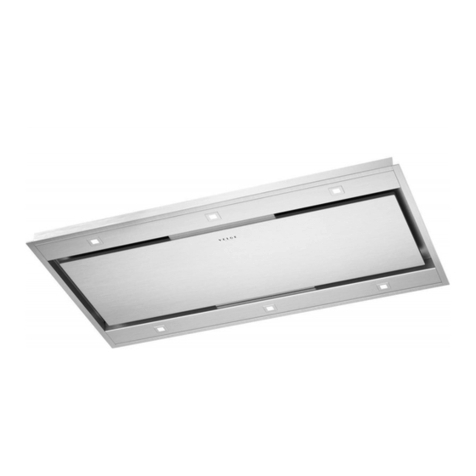
Szczególną uwagę należy zwrócić na metalowe ltry przeciwtłuszczowe,
które są przeznaczone do wychwytywania cząsteczek tłuszczu zawartych
w oparach. Metalowe ltry przeciwtłuszczowe należy myć co najmniej raz
w miesiącu przy użyciu detergentu i w gorącej wodzie (lub w zmywarce).
UWAGA: tłuszcz, który gromadzi się w ltrach może łatwo zapalić się,
dlatego niezwykle ważne jest, aby metalowe ltry czyścić regularnie
i zgodnie z instrukcją.
Filtry węgla aktywnego przeznaczone są do usuwania nieprzyjemnych
zapachów z kuchennych oparów. Oczyszczone powietrze jest następnie
uwalniane do środowiska. Filtrów węglowych nie należy myć,
natomiast należy je wymienić 2 do 3 razy w roku w zależności od tego,
z jaką częstotliwością korzysta się z okapu. Nowe ltry należy nabyć
bezpośrednio u producenta.
W celu przeprowadzenia wymiany ltrów metalowych, podnieść
drzwiczki szklane i usunąć ltry metalowe (rys. 3). Nacisnąć przyciski
(H), aby odczepić płytki (rys. 4-I). Teraz można już dotrzeć do ltrów
węglowych. Obrócić ltry w sposób pokazany na rys. 4 do chwili, kiedy
pochłaniacz zostanie zwolniony i wymienić je na nowe. Wymienić płytki
(I), nacisnąć ponownie na przyciski (H) w celu ich zamocowania.
Zarówno wewnętrzną, jak i zewnętrzną część okapu należy czyścić
często (co najmniej raz w miesiącu). Nie należy pozwolić na to, aby
zanieczyszczenia gromadziły się na wewnętrznej i zewnętrznej
powierzchni okapu.
Do czyszczenia obudowy okapu nie należy używać kwasu lub produktów
podstawowych ani też gąbek ściernych.
Czyścić okap gąbką zwilżoną ciepłą wodą i małą ilością neutralnego
detergentu (np. detergentu do zmywarek) w celu usunięcia ewentualnych
cząstek tłuszczu.
Opłukać okap wilgotną szmatką, starannie usuwając wszystek detergent
zgodnie z kierunkiem polerowania powierzchni ze stali. Suszenie okapu
jest bardzo ważne, szczególnie w miejscach, gdzie woda jest szczególnie
twarda i pozostawia osad wapienny.
OSTRZEŻENIA
T3 odpowiada 15-ciu minutom
W chwili działania samoczynnego wyłączania możliwa jest modykacja
wcześniej zaprogramowanej prędkości.
Jeżeli wybór czasu samoczynnego wyłączenia się odpowiada ustawionej
prędkości, wówczas dioda prędkości miga, w przeciwnym wypadku dioda
świeci się światłem stałym.
Przypomnienie o potrzebie przeprowadzenia konserwacji ltrów
Aluminiowe ltry przeciwtłuszczowe
W chwili gdy okap jest wyłączony po kolejnych 30 godzinach jego
eksploatacji, wszystkie diody przycisków prędkości włączają się świecąc
się światłem stałym przez 30 sekund, aby przypomnieć, że aluminiowe
ltry przeciwtłuszczowe wymagają czyszczenia. Aby wyzerować timer
przytrzymać wciśnięty przycisk T1 przy wyłączonym pochłaniaczu,
w przeciwnym razie timer pozostanie ustawiony na 30 godzin eksploatacji
i przypomnienie powtórzy się, w chwili, gdy okap zostanie wyłączany. Filtr
węglowy (do ltrowania okapów)
W chwili gdy okap jest wyłączony po kolejnych 60 godzinach jego
eksploatacji, wszystkie diody migają przez 30 sekund, aby przypomnieć,
że ltr węglowy wymaga czyszczenia. Aby wyzerować timer przytrzymać
wciśniętyprzyciskT1przywyłączonympochłaniaczu,wprzeciwnymrazie
timer pozostanie ustawiony na 120 godzin eksploatacji i przypomnienie
powtórzy się, w chwili, gdy okap zostanie wyłączany.
W chwili gdy okap jest wyłączony po kolejnych 480 godzinach jego
eksploatacji, wszystkie diody migają przez 30 sekund, aby przypomnieć,
że ltr węglowy wymaga czyszczenia.
Aby wyzerować timer przytrzymać wciśnięty przycisk T1 przy
wyłączonym pochłaniaczu, w przeciwnym razie timer pozostanie
ustawiony na 120 godzin eksploatacji i przypomnienie powtórzy się,
w chwili, gdy okap zostanie wyłączany
KONSERWACJA
Zawsze przed przystąpieniem do czynności konserwacji lub
czyszczenia należy odłączać okap od zasilania.





































